
by Mary Caperton Morton Thursday, January 5, 2012
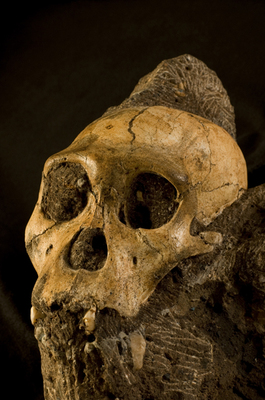
The cranium of the juvenile_ Australopithecus sedib_a. Brett Eloff, picture courtesy of Lee Berger and the University of the Witwatersrand
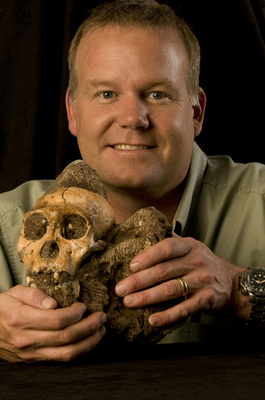
Lee Berger of the University of the Witwatersrand with the _Australopithecus sediba_ skull. Picture courtesy of Lee Berger and the University of the Witwatersrand
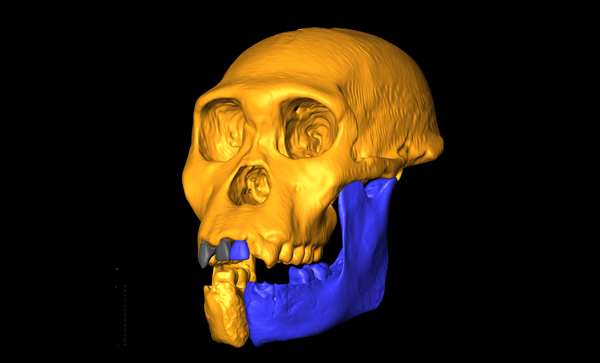
_Australopithecus sediba_ skull reconstruction. ESRF, picture courtesy of Lee Berger and the University of the Witwatersrand
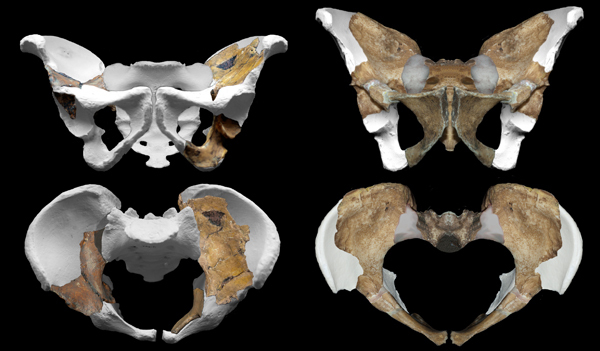
Reconstructed pelvises of the juvenile male (left) and adult female (right) _Australopithecus sediba_ specimens. Peter Schmid, courtesy of Lee Berger and the University of the Witwatersrand
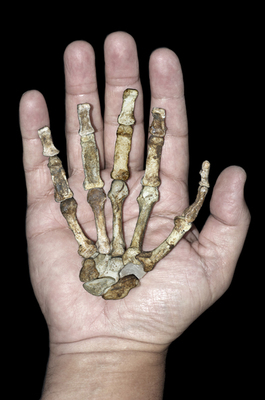
Right hand of the adult female _Australopithecus sediba_ against a modern human hand. Peter Schmid, courtesy of Lee Berger and the University of the Witwatersrand
Mapping out how one species of early hominin branches to another has always been complicated by the rarity of complete specimens and lack of precise dating methods for fossils more than 50,000 years old. Now researchers studying the braincase, pelvis, hands and feet of a primitive hominin — which lived about the same time early Homo species were evolving — are taking full advantage of a rare, nearly complete assemblage of fossils and a new highly accurate dating method to once again redraw humankind’s ancient lineage.
Last year, fossils from two individuals — a juvenile male and an adult female, dubbed MH-1 and MH-2 respectively — were recovered from the prolific early hominin site at the caves of Malapa, 45 kilometers northwest of Johannesburg, South Africa. In a study published in Science in April 2010, project leader Lee Berger of the University of the Witwatersrand in Johannesburg, South Africa, and colleagues announced that the fossils belonged to a new species of early hominin — Australopithecus sediba — initially dated to between 1.95 and 1.78 million years ago.
A new series of studies on the fossils, published in Science in September, takes what Berger calls “a highly technological look at an unprecedented collection of extraordinarily complete early hominin fossils.” The five studies describe the most complete hand ever found in an early hominin, one of the more complete pelvises ever discovered, and neverbefore- seen pieces of the foot and ankle. The studies also boast a high-resolution scan of the inside of an early hominin’s cranium along with work that refines the date of this early hominin site to 1.977 million years ago, close to the emergence of the genus Homo.
“The new studies make it clear that this ancient relative displayed both primitive characteristics as well as more modern, human-like traits” Berger said in a podcast provided by the University of the Witwatersrand. For example, the nearly complete, articulated hand looks “a lot like ours,” with shortened fingers and a grip that’s more human-like than ape-like. But the hand is attached to an arm that is elongated and distinctly apelike, suggesting an intermediate species suited to both climbing trees and making primitive tools.
The foot and ankle bones are also a mixture of primitive and modern, showing evidence for a human-like arch and a well-defined Achilles tendon, but with a more ape-like heel and shin bone, suggesting a unique bipedal gait and strong ability to climb trees.
Perhaps the most surprising study is that of the brain, Berger said, which at 420 cubic centimeters in size is among the smallest early hominin braincases ever recovered. But despite its diminutive size, the endocast — a cast made of the inside of the cranium — suggests that the brain of A. sediba had already begun to reorganize in a very human way.
“It may be small but it’s not shaped like other primitive early hominins like Lucy,” Berger said, referring to the most famous specimen of Australopithecus afarensis, which existed about a million years before A. sediba. “The shape is more advanced, and more humanlike in its proportions.”
The pelvis, though small, is also decidedly modern in shape, calling into question the long-held Obstetric Hypothesis that early Homo pelvises evolved to their modern bowl-shape to accommodate expanding craniums.
These findings challenge one of the longest-held theories of human evolution: that our expanding brains were what made us human. “The most thought-provoking aspect of these papers is the need to rethink some of the major reasons for evolutionary change — such as the advantage of a large brain,” says Richard Potts, director of the Smithsonian’s Human Origins Program in Washington, D.C., who was not involved in the new studies.
“In previous definitions of our genus, the leading edge in the emergence of Homo has always been brain enlargement,” he says. “The A. sediba bones show, however, that reorganization of the brain and pelvis typically connected with the evolution of Homo need not have involved brain enlargement.”
In addition to the detailed skeletal studies, the team also found a more precise way to date these fossils that has never before been used on early hominins. Fossils more than 50,000 years old are notoriously difficult to date because they’re out of the range of radiocarbon dating methods.
The team, led by Robyn Pickering of the University of Melbourne in Australia, used uranium and lead isotopes to date the layers of limestone that capped and underlay the deposit containing the two skeletons. They then used paleomagnetic dating methods to further refine the age of the fossils, which correlated with a very specific, well-known reversal of Earth’s magnetic poles that occurred between 1.98 million and 1.977 million years ago.
“This is the most accurate date ever achieved for an early hominin, absolutely in southern Africa, maybe in all of Africa,” Berger said. “Not only will it allow us to really figure out where this species fits in time and place relative to all the other discoveries, but we can also go back and apply this technology to all the other sites too,” which could help narrow some of the wide error bars plaguing dating studies of early hominin fossils.
Overall, the skeletal evidence and the specific dates show strong evidence in support of the idea that A. sediba may have been close to the root of the Homo branch of the hominin family tree. “The many advanced features found in the brain and body, along with the earlier date, make it possibly the best candidate ancestor for our genus — the genus Homo — more so than previous discoveries, such as Homo habilis,” Berger said. That means that rather than a cousin, A. sediba was very possibly a direct ancestor of Homo erectus, and thus of Homo sapiens.
Until now, fossils dated to about 1.9 million years ago, mostly attributed to Homo habilis and Homo rudolfensis, have been considered direct ancestors to Homo erectus, the earliest undisputed ancestor of modern humans that lived between 1.9 million and 70,000 years ago. Homo sapiens first appeared on the scene about 200,000 years ago. But the older age of the A. sediba fossils raises the possibility of a separate, older lineage from which Homo erectus may have evolved, Berger said.
“I’m certain that this contention will be controversial,” Potts says. At this point, he says, “I think A. sediba offers an amazing snapshot of early human evolution. Out of this experimentation arose several of the hallmarks of the human lineage, but there’s much still to learn about how it all occurred.”
© 2008-2021. All rights reserved. Any copying, redistribution or retransmission of any of the contents of this service without the expressed written permission of the American Geosciences Institute is expressly prohibited. Click here for all copyright requests.